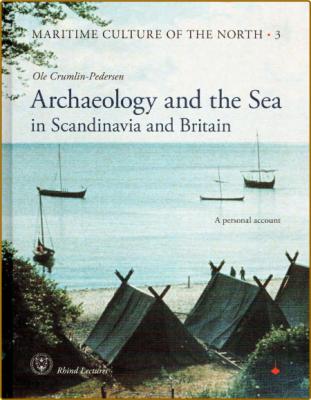 Archaeology and the Sea in Scandinavia and Britain - A Personal Account
Archaeology and the Sea in Scandinavia and Britain - A Personal Account
Mar Jun 28, 2022 7:35 am

[/center]
pdf | 58.42 MB | English | Isbn: 978-8785180056 | Author: Ole Crumlin-Pedersen | Year: 2010
[/center]
Description:
Half a century ago, archaeology entered a new field of work with the excavation of ancient ships found under water. A new discipline emerged: maritime archaeology. In this book, Ole Crumlin-Pedersen, the Danish pioneer of maritime archaeology, gives a fascinating overview of more than forty of years of work. Beginning with the natural conditions for seafaring, the author explains the evolution of basic water craft into those plank-built, sail-carrying ships which enabled the seaborne activities of the Viking Age and the following medieval periods, concluding with case studies of the maritime cultural landscape of Roskilde Fjord and the ship as symbol. The themes of this volume were first presented in six Rhind Lectures for the Society of Antiquaries of Scotland in Edinburgh in 2008.
Table of Contents
Foreword ( Barbara Crawford & Tinna Damgård-Sørensen ); Introduction; I. Studying The Archaeology of Maritime Cultures ; The seafarer's geographical framework; What defines a maritime culture?; The potentials of waterlogged sites; Studying maritime archaeology; The ship; Some aspects of Danish maritime archaeology; Hydrography and shipping lanes; A national and international research programme; The Danish situation; Other ship finds; The Centre for Maritime Archaeology in Roskilde; Publications; Two examples; Hjortspring, a large Pre-Roman war canoe ; The history of Skuldelev 2, a Dublin-built 11th-century longship ; Shipbuilding resources and craftsmanship; Sea trials and voyages
I I. Boats and Ships Before AD 800 ; Wood technology and tools ; The ethnographical evidence for basic boatbuilding concepts and materials; Skin/hide boats; Bark boats; Logboats; Expanded logboats; Outriggers and composite logboats; Plank boats; The archaeological evidence ; Mesolithic boats; Neolithic and Bronze-Age logboats; Bronze-Age logboat-based complex vessels; The Dover boat; The Ferriby boats and the Brigg craft; The concepts of the Bronze-Age boats; Romano-Celtic vessels; Nordic ship images; Hjortspring; Expanded boats; Nydam; Roman influence; Sutton Hoo; Paddles, oars, sail; From Nydam to the Vikings
III. Anglo-Saxon and Scandinavian Longships ; The origin of longship concept; Maritime expertise; The source groups; Four conceptual approaches; The vessels of Franks and Frisians; The ships of Britain and Ireland; Ships of Scandinavia and the Baltic area; Viking longships; The Hedeby I longship; The Skuldelev 5 ship; Roskilde 6, a royal longship at the doorstep of the Viking Ship Museum; The Puck longship; The ship as a status object; Names for the ship types; Longships in Central and Southern Europe; Conclusion; The aftermath of the longship period
IV. The Ships of Viking-Age and Medieval Traders and Settlers ; The world of the Vikings; Sutton Hoo; The introduction of the sail; Viking expansion, loot or trade?; The early Viking phase, c. 700-840 ; Trade and early centres; Ribe, the first Danish town?; The middle Viking phase, c. 840-950 ; The early Christian mission; Vikings in the West; Scandinavian settlement in Scotland and Ireland Ships and boats in Scotland; Othere's voyages; Wulfstan's voyage; The late Viking phase, 950-1100 ; State formation and control of the shipping lanes; The North Atlantic route; Skuldelev 1, a medium-sized Norwegian knorr; Skuldelev 3, a small Danish byrding; Hedeby 3, a large Danish knorr; Scandinavian ships of the period 1100-1250 ; The Baltic expansion; Large clinker-built cargo ships; Small vessels; Other high-and late-medieval ship types; The early cogs; Later cogs; The hulc; British high-and late-medieval ships; Conclusion
V. The Maritime Cultural Landscpae ; The Skuldelev example; Routes across land and sea; Roskilde Fjord ; An ancient cultural landscape; Skuldelev fieldwork; Reconstruction of the paleo-landscape; Early warning systems - a hypothetical reconstruction; Lejre - Roskilde - Copenhagen; The coast as a contact zone along the Roskilde Fjord
VI. The Ship as Symbol in the Scandinavian Iron Age and Viking Period ; Ship representations in several media; Traditional interpretations; Criteria for boat graves; 'Rich' graves with ships and boats; 'Ordinary' grave boats; The Slusegård cemetery ; Grave 1072; The Slusegaard boat graves in general; Male and female graves; The interpretation of the boat grave custom ; The two families of gods; Skidbladnir; The confrontation with the Christian mission ; Sutton Hoo; Oseberg; Large stone ships; Transition to Christianity; The source value of icons; Summary of the evidence from boat graves and stone ships; The Valhalla myth; King Scyld and the Beowulf poem; Bibliography ; About the author; Index
Category:Scandinavian History, Archaeology
https://rapidgator.net/file/d605292df4f8bb7a3335a5ea5b004ef6/
[/center]
https://1dl.net/3q4r6i70u91r
Permisos de este foro:
No puedes responder a temas en este foro.


